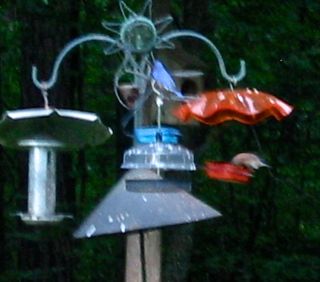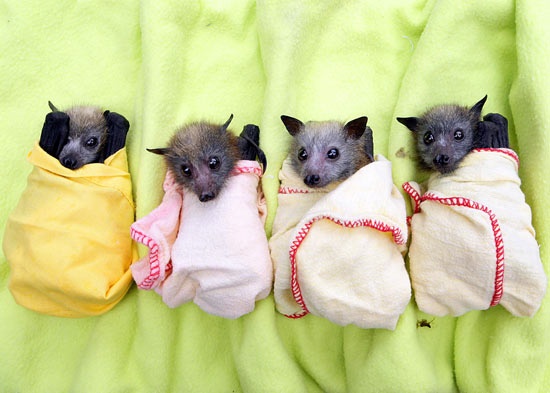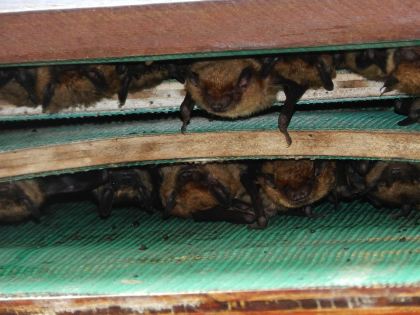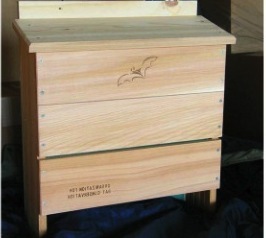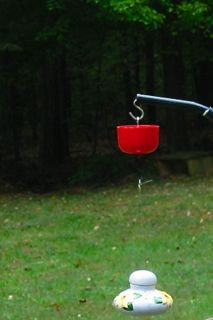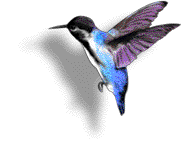-
make room mr. tube bird feeder
Fuzzy picture but great subject matter! That’s Mr. and Mrs. Bluebird again, and tonight they coaxed their babies to the feeders. Of five fledges, two are out and about so far, and mom and dad have claimed the same house for nesting number two.
All those feeders hang from one garden pole, plus an extender branch (which hasn’t even made it to the website yet). They’re great for hanging additional smaller items and give birds lots of perching space around feeders. Last year a small hanging bath was added to the branch. What are all those feeders, and do you think anymore would possibly fit on this pole? Three dishes for mealworms… they’re most popular this time of year as everyone is feeding babies! Cardinals, Catbirds, Nuthatches, Chickadees, Titmice, Phoebes, Carolina Wrens, and of course… the bluebirds. The meal worm grower loves me 🙂 The dark little cup… jelly for the Catbirds. And of course the cone shaped squirrel baffle, it’s a must on every feeder pole around the yard!
The silver silo, or tube bird feeder sees little activity as compared to the worm dishes. It’s filled with Finch Mix, but Goldfinches seem to prefer straight thistle this time of year. Why? Babies! Their diet is pretty exclusive to the tiny black nyjer seed. Another tube feeder containing shelled peanuts is seeing some action, but the worms win hands down!
And speaking of tube bird feeders – have you seen the spiral ones? They’re way cool as more birds get to perch and eat at once. The tubes feature an “all-over” feeding area, and the spiral allows birds to land and eat anywhere on the feeder. No more waiting for an open perch. Available for peanuts, thistle, or mixed seed.
Next time you’re in the grocery store, pick up some grape jelly for the birds. That dish is actually a glass votive holder, but works great for offering jelly too. And don’t forget the oranges as Orioles love them too. Spring may have sprung a little late this year, but the bird show is definitely on!
-
Beneficial Bat Houses
Bats could really use a new image!
Helping to demystify the furry creatures and their role in biodiversity would suit them and us well. This photo? Picked off Pinterest, but it sure is kind of cute! But do bats really roost in bat houses? You bet they do if habitat is suitable.
And just why would you want them around your property?
For insect control, bats can eat thousands of mosquitoes and flying pests each night. As a natural and effective method it’s brilliant. As pollina
tors, they spread and cross-pollinate both annuals and perennials in the garden. As an endangered species, yes! Brown bats are facing decimation due to a virus that still has scientists baffled. White Nose Syndrome is causing controversy with Fish and Wildlife Services – as far as revenue-generating options. Opening caves to the general public as tourist attractions seems to be an ill-thought idea in lieu of the disease and decrease in bat population numbers. Is it a concern? Just ask any farmer who’s had crops wiped out due to an over abundance of insects and pests 🙁
Hundreds of brown bats (or any large group) are referred to as colonies. Larger bat houses containing three or more chambers will host whole colonies. Houses or shelters do not require cleaning or nest removal like birdhouses, simply because they’re used for roosting only.
Suitable habitat consists of nearby woods or heavy brush, preferably with creeks, lakes, or streams in close proximity. Height is important, as bat houses should be placed at least 15-20 feet above ground. Erected on a pole, or the side of a structure is best. The range is broad on the size and type of shelters available. From
smaller kits and single-chamber houses for experimenting, to decorative and larger houses to host whole colonies, we’d say it’s definitely worth a try this season!
-
It can’t be time for the ant moat yet?
Dry, dry, dry, it’s been a hot and dry start to summer in the Southeast, which means crawlies of all sorts are already seeking moisture. Pastures are starting to turn crispy as the lush grasses of spring fade away. Sticky nectar solutions we use to lure hummingbirds are always a major attraction for ants, who can become a real nuisance to birds and humans. The tiny sprites just don’t like ants in their nectar… period!
Not only for hummingbird feeders, you can protect oriole, butterfly, and fruit & jelly feeders easily with an ant moat. It will fend off pesky ants by blocking their path with water – because ants can’t swim. The vessel must have water to function properly! No water-no moat-get ants 🙁
Another option is to dab some petroleum jelly on the hook or bracket of the feeder. This works okay for a bit… until the heat melts it and makes a mess. You’d want to be sure nothing drips into the nectar as well.
Lots of hummingbird activity in the beginning of the season seems to have slowed, and even has folks asking where they are? Because flowers and vines are still offering food sources by way of nectar, they’ll always be the first and most natural choice. Due to the harsh winter and late spring, blooms don’t seem to coincide with the time! Our cactus which usually flowers in may, is now in full bloom one month later. than normal. But come July when everything has shriveled, hummingbird activity is sure to increase once again at feeders, so don’t take them down, and do keep nectar fresh.
Pouring too much of that nectar down the drain? First, don’t fill feeders to capacity, and do try the home-made sugar water solution. It’s perfect, and we think hummingbirds prefer it over commercial mixes! No red dye needed either. This simple recipe? 1 cup plain table sugar to 4 cups water… that’s it! Boil just one cup of water to dissolve sugar, add three cups cold water, stir well… and you’re ready to fill. Store unused nectar in the fridge f
or up to two weeks.
May the tiny sprites bring a smile upon your face, and may you see lots of buzzing activity around your feeders this season!

